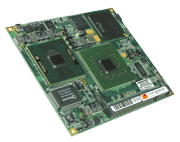Hypervisor divvies up multi-core systems between Linux, VxWorks
Feb 28, 2007 — by LinuxDevices Staff — from the LinuxDevices Archive — 3 viewsGermany-based Real-time Systems (RTS) is readying a hypervisor product said to enable multi-core processors to simultaneously run an RTOS (real-time operating system) and a GPOS (general-purpose operating system), while preserving the RTOS's real-time determinism. The RTS Real-Time Hypervisor, currently in beta, initially supports VxWorks and Linux, according to the company.
RTS expects its Hypervisor technology to be used in cases where real-time extensions available for Linux do not offer adequate real-time determinism. Cited examples include applications in industrial automation, medical devices, telecommunications systems, and military equipment.
The RTS Hypervisor works by assigning an RTOS and GPOS to separate cores in multi-core processors, such as Intel Core Duo processors. Like other platform virtualization technologies, it also divides physical memory and hardware devices between the two OSes. Shared memory or a TCP/IP-based virtual network driver is used for communication between OSes. Users can specify the boot sequence, and even reboot one OS while the other remains in full operation, according to the company.
Availability
 RTS's Hyperviser is currently beta-testing, with availability expected this summer. The technology was demonstrated running Linux and VxWorks on Congatec's Conga-x945 embedded processor module (photo at right), at the Embedded World Exhibition and Conference in Nuremberg, Germany last week.
RTS's Hyperviser is currently beta-testing, with availability expected this summer. The technology was demonstrated running Linux and VxWorks on Congatec's Conga-x945 embedded processor module (photo at right), at the Embedded World Exhibition and Conference in Nuremberg, Germany last week.
Meanwhile, platform virtualization specialist VirtualLogix has previously demonstrated its VLX product on Core Duo and Core Solo Intel processors.
This article was originally published on LinuxDevices.com and has been donated to the open source community by QuinStreet Inc. Please visit LinuxToday.com for up-to-date news and articles about Linux and open source.